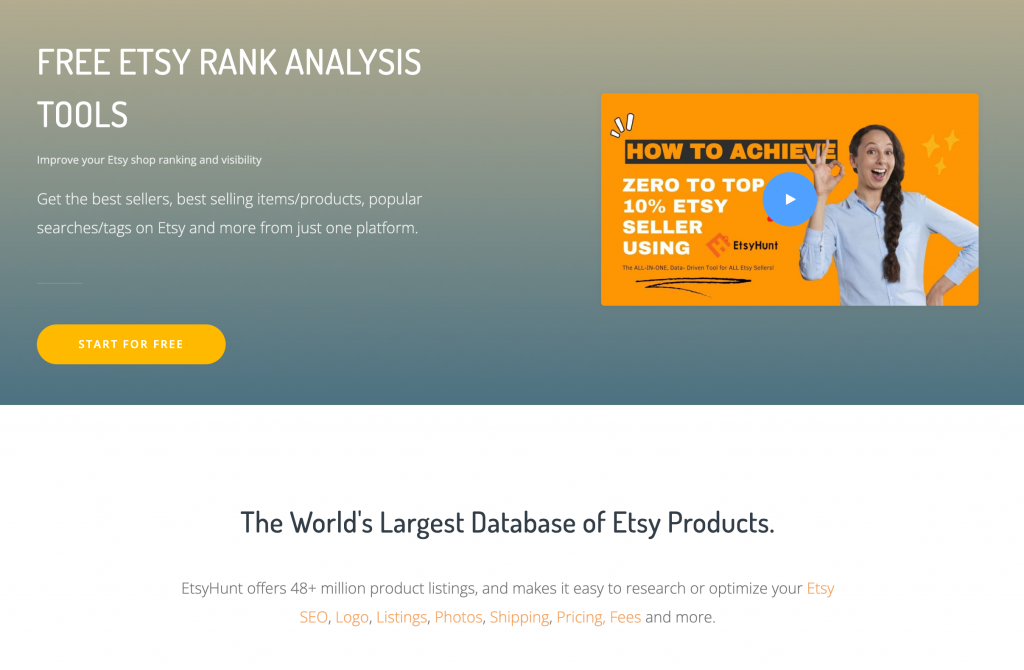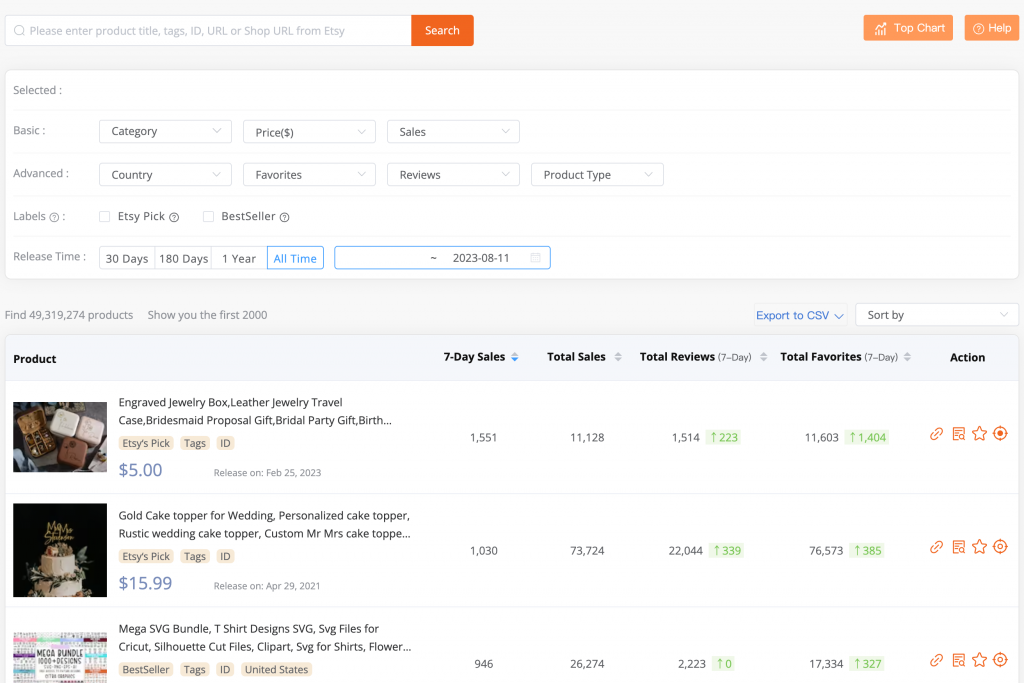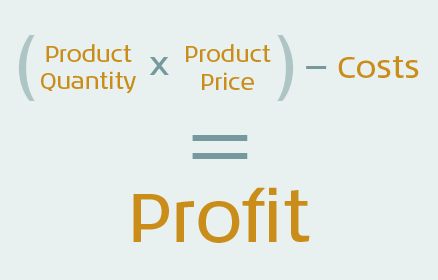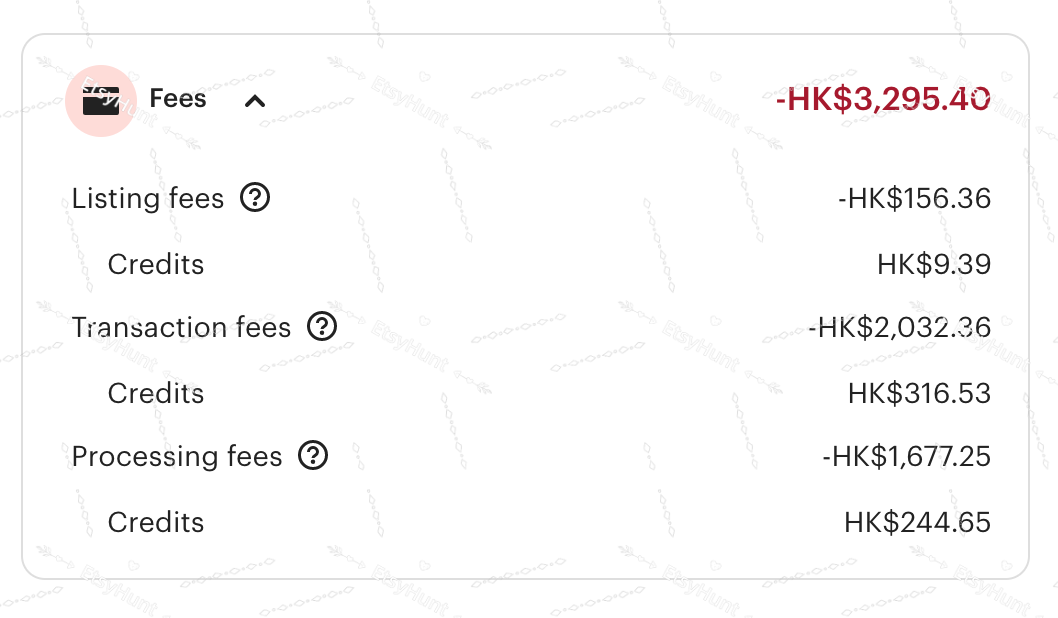How to Use EHunt for Effective Etsy Data and Business Analysis
Etsy is an e-commerce platform that focuses on handmade and unique products. It connects buyers and sellers from all over the world, and provides an opportunity to showcase and sell their own creations. Etsy’s sales reached $10.28 billion in 2020, an increase of 106.7% from 2019. Behind this amazing growth, there are a lot of data and business analysis that help Etsy optimize its operations, marketing, products and services.
So, how to do Etsy data and business analysis? This article will introduce some basic concepts and methods, as well as a practical tool - EHunt, which can help you quickly get and analyze Etsy data, and improve your Etsy shop’s performance.
What is data analysis?
Data analysis is the process of processing, organizing, describing, explaining and presenting the collected data, to discover the patterns, trends, relationships and insights in them, and to support decision making and action. Data analysis can be divided into the following steps:
● Data collection: This is the first and most important step of data analysis. Data collection is to obtain relevant data from different sources, such as websites, apps, social media, surveys, transaction records, etc. The purpose of data collection is to meet specific analysis needs, so you need to clarify the scope, method, frequency and quality of data collection.
● Data cleaning: This is the second and most time-consuming step of data analysis. Data cleaning is to check, correct, delete or supplement the collected data, to eliminate the errors, duplicates, missing or inconsistent parts in them. The purpose of data cleaning is to ensure the accuracy, completeness and consistency of data.
● Data organization: This is the third and most critical step of data analysis. Data organization is to classify, sort, filter, merge or split the cleaned data, to facilitate the subsequent analysis. The purpose of data organization is to make the data more orderly, concise and easy to understand.
● Data description: This is the fourth and most basic step of data analysis. Data description is to use statistics and visualization to show the basic characteristics of the organized data, such as quantity, average value, median value, standard deviation, maximum value, minimum value, etc. The purpose of data description is to provide an overview of the data.
● Data interpretation: This is the fifth and most advanced step of data analysis. Data interpretation is to use inference and prediction to reveal the inherent logic, causal relationship, correlation or trend in the described data. The purpose of data interpretation is to provide a deep understanding of the meaning and value behind the data.

What is business analysis?
Business analysis is the process of diagnosing, evaluating and recommending solutions for the problems or opportunities that a business or organization faces in the market environment, to improve its competitiveness and efficiency. Business analysis can be divided into the following steps:
● Problem definition: This is the first and most important step of business analysis. Problem definition is to identify the problem or opportunity that a business or organization wants to solve or exploit, and translate it into specific analysis objectives and questions. The purpose of problem definition is to determine the direction and scope of analysis.
● Data acquisition: This is the second and most basic step of business analysis. Data acquisition is to select or generate relevant data from data analysis according to problem definition, such as indicators, variables, dimensions, etc. The purpose of data acquisition is to provide the necessary data for analysis.
● Data analysis: This is the third and most core step of business analysis. Data analysis is to use different analysis methods and techniques to explore, verify, model or optimize data, to obtain valuable information and insights. The purpose of data analysis is to answer analysis questions or achieve analysis objectives.
● Result presentation: This is the fourth and most critical step of business analysis. Result presentation is to present and explain the results of data analysis in a clear, concise and persuasive way, such as reports, charts, dashboards etc. The purpose of result presentation is to convey analysis conclusions and recommendations.
● Action implementation: This is the fifth and most advanced step of business analysis. Action implementation is to formulate and execute corresponding action plans based on result presentation,to solve or exploit problems or opportunities,and monitor and evaluate action effects. The purpose of action implementation is to realize analysis value.
What is EHunt?
EHunt is a data and business analysis tool specially designed for Etsy sellers. It can help you quickly get and analyze product,keyword,and shop data on Etsy,and improve your Etsy shop’s performance in search ranking,traffic,conversion rate,and sales volume.
EHunt has three main functions:
● Product research: This function allows you to search and browse more than 30 million products on Etsy,and view their detailed information,such as total sales,weekly sales,reviews,favorites,price,images,etc. You can filter and sort by different criteria,to find the most popular,most profitable or most suitable products for your shop style and positioning. You can also view the keywords and tags used by each product,and copy them to your own product list with one click,to improve your product ranking in search results.
● Keyword research: This function allows you to search and analyze popular keywords on Etsy under different categories,and view their important indicators,such as search volume,competition,click-through rate,etc. You can filter and sort by different criteria,to find the most relevant,most popular or most profitable keywords. You can also view the top ten products under each keyword,and learn how they use title,description,image and other elements to attract buyers.
● Shop research: This function allows you to search and compare data of different shops on Etsy,and view their core indicators,such as total sales,weekly sales,reviews,favorites,product number,etc. You can filter and sort by different criteria,to find the most successful,most influential or most worth learning shops. You can also view the products sold by each shop,and discover their marketing strategies, pricing strategies, etc.
EHunt also has a Chrome browser extension, which allows you to get relevant data directly when browsing Etsy website, and provides some useful functions, such as one-click copy of title, description, tags, etc.
This article introduces the basic concepts, methods and steps of how to use EHunt for Etsy data and business analysis, and demonstrates how to use EHunt to improve shop ranking in search results with a practical example. Of course, this is just a simple example, you can use EHunt to do more data and business analysis according to your own analysis objectives and questions, to improve your Etsy shop’s performance.

How to use EHunt for Etsy data and business analysis?
EHunt is a very simple and easy to use tool. You only need to register an account, and you can use all its functions for free. Below, we will demonstrate how to use EHunt for Etsy data and business analysis with a practical example.
Suppose you are a seller who sells handmade leather products on Etsy, and you want to improve your shop’s ranking in search results, to attract more buyers. You can follow these steps to do data and business analysis:
Step 1: Problem definition First, you need to identify the problem or opportunity that you want to solve or exploit, and translate it into specific analysis objectives and questions. For example, you can define it as follows:
● Analysis objective: Improve shop ranking in search results
● Analysis question: How to optimize product title, description, tags and other elements, to improve the matching degree and click-through rate with popular keywords?
Step 2: Data acquisition Second, you need to select or generate relevant data from data analysis according to problem definition. For example, you can use EHunt’s keyword research function to get the following data:
● Popular keywords: Search and analyze popular keywords related to handmade leather products on Etsy, and view their important indicators, such as search volume, competition, click-through rate, etc. For example, you can find that “leather journal”, “leather wallet”, “leather bag” are some very popular and profitable keywords.
● Competitive products: View the top ten products under each keyword, and learn how they use title, description, image and other elements to attract buyers. For example, you can find that some successful products use the following title format: “[Keyword] - [Feature] - [Brand]”. For example, “Leather Journal - Personalized - Rustico”.
Step 3: Data analysis Next, you need to use different analysis methods and techniques to explore, verify, model or optimize data, to obtain valuable information and insights. For example, you can use EHunt’s product research function to do the following analysis:
● Product comparison: Search and browse products on Etsy that are similar to your shop style and positioning, and view their detailed information, such as total sales, weekly sales, reviews, favorites, price, images, etc. You can filter and sort by different criteria, to find the most popular, most profitable or most suitable products for your shop style and positioning. For example, you can find that some high-sales products use the following image style: “[Natural light] - [Simple background] - [Clear detail]”. For example, “[Natural light] - [White background] - [Close-up detail]”.
● Product optimization: View the keywords and tags used by each product, and copy them to your own product list with one click,to improve your product ranking in search results. You can also optimize your product title,description,image and other elements according to EHunt’s suggestions. For example,you can find some optimization suggestions as follows: “[Increase keyword density] - [Reduce irrelevant words] - [Highlight selling point]”. For example,“[Increase keyword density] - [Reduce irrelevant words] - [Highlight selling point]”.
Step 4: Result presentation Then,you need to present and explain the results of data analysis in a clear,concise and persuasive way. For example,you can use EHunt’s dashboard function to do the following presentation:
● Dashboard: Create and view the core indicators of your shop and products,such as total sales,weekly sales,reviews,favorites,product number,etc.,and compare them with other shops and products. You can also view the performance of your shop and products in different time periods,different categories,different regions and other dimensions,and discover the changes and trends in them. For example,you can find that your shop’s ranking under the keyword “leather journal” has risen from 20th to 10th in the past month.
● Report: Generate and download detailed reports of your shop and products,including data analysis results,conclusions and recommendations. You can also customize the content,format and style of the report,to suit different occasions and purposes. For example,you can generate a report on how to improve shop ranking in search results,including the following content: “[Problem definition] - [Data acquisition] - [Data analysis] - [Result presentation] - [Action recommendation]”. For example,“[Problem definition] - [Data acquisition] - [Data analysis] - [Result presentation] - [Action recommendation]”.
Step 5: Action implementation Finally,you need to formulate and execute corresponding action plans based on result presentation,to solve or exploit problems or opportunities,and monitor and evaluate action effects. For example,you can use EHunt’s tracking function to do the following implementation:
● Tracking: Set and view the goals and progress of your shop and products,and compare them with other shops and products. You can also view the performance of your shop and products in different time periods,different categories,different regions and other dimensions,and discover the changes and trends in them. For example,you can set a goal to improve shop ranking in search results,such as “Increase the ranking under the keyword ‘leather journal’ to the top five within a month”.
● Evaluation: Collect and analyze the feedback data of your shop and products,such as reviews,ratings,favorites,returns,etc.,and compare them with other shops and products. You can also view the performance of your shop and products in different time periods,different categories,different regions and other dimensions,and discover the changes and trends in them. For example,you can analyze an evaluation result of improving shop ranking in search results,such as “Within a month,the click-through rate under the keyword ‘leather journal’ increased by 50%,the conversion rate increased by 30%,and the sales volume increased by 40%”.

Summary and conclusion
Etsy is a very interesting and challenging e-commerce platform. It provides an opportunity to showcase and sell your own creations, but also poses a problem of how to stand out in a competitive market. Etsy data and business analysis is an effective method that can help you better understand your shop, products, customers and competitors, and optimize your operations, marketing, products and services.
EHunt is a data and business analysis tool specially designed for Etsy sellers. It can help you quickly get and analyze product, keyword, and shop data on Etsy, and improve your Etsy shop’s performance in search ranking, traffic, conversion rate, and sales volume. EHunt has three main functions:
● Product research: Allows you to search and browse more than 30 million products on Etsy, and view their detailed information.
● Keyword research: Allows you to search and analyze popular keywords on Etsy under different categories, and view their important indicators.
● Shop research: Allows you to search and compare data of different shops on Etsy, and view their core indicators.
EHunt also has a Chrome browser extension, which allows you to get relevant data directly when browsing Etsy website, and provides some useful functions, such as one-click copy of title, description, tags, etc.
This article introduces the basic concepts, methods and steps of how to use EHunt for Etsy data and business analysis, and demonstrates how to use EHunt to improve shop ranking in search results with a practical example. Of course, this is just a simple example, you can use EHunt to do more data and business analysis according to your own analysis objectives and questions, to improve your Etsy shop’s performance.





